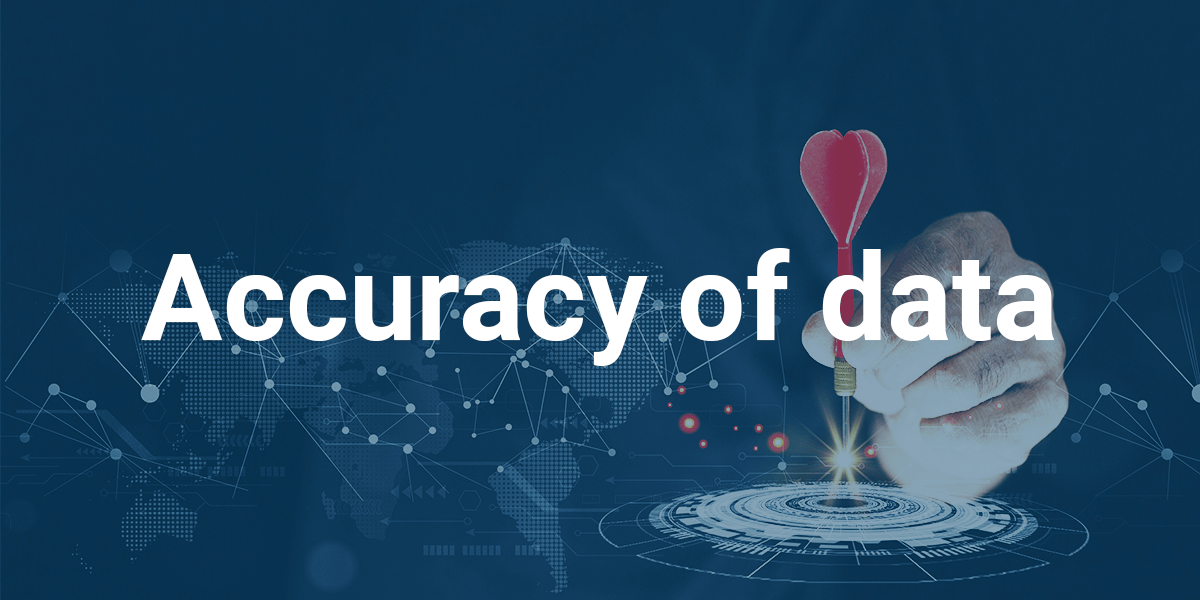In the same way that a slight error in alignment can cause a dart to miss the target, even a small error in data can result in flawed insights and misguided strategies. This is why businesses accuracy of data to create reliable business decisions.
But because measuring data accuracy isn’t straightforward, this article will shed light on what businesses can do to maintain and track it.
Data Accuracy: Table of Contents
What is Data Accuracy?
Data accuracy emphasizes the correctness, consistency, and reliability of data available to an organization. It’s one of the six dimensions of data quality, concentrating on how closely data reflects actual business values or conditions.
With accurate data, IT and business leaders can drive growth, profitability, and performance. It helps organizations with:
- Operational efficiency
- Innovation
- Adherence to regulations
- Improved customer satisfaction
Data is considered inaccurate if it’s technically wrong, misrepresented, insufficient, and unclear. Examples of factors that can compromise data accuracy include human errors (ex: duplicate entries, erroneous entries) and system errors (ex: outdated software, bugs).
Here’s an example from the insurance industry of what might happen if data accuracy isn’t monitored:
In the case of inaccurate policyholder details, coverage details, and premium payments, insurance providers can immediately lose credibility and customer confidence. Furthermore, if these errors result in delayed payouts, customers are likely to withdraw from the business or file lawsuits.
By keeping tabs on data accuracy, companies can prevent such negative consequences. But measuring it presents a hurdle. Traditionally, companies stack their collected data against what’s often referred to as a “golden source” to measure data accuracy. However, today’s complex data environments make finding the golden source–a robust, accessible, and reliable data repository–a feat of its own.
Why Modern Companies Struggle To Measure Data Accuracy
Data-driven organizations face the challenge of identifying a “golden source” because they operate in multi-layered data environments, combining data from various sources. Given this tricky situation, there might not even be a definitive golden source to turn to.
It becomes a futile exercise, assuming that the only way to measure data accuracy is to contrast it with a possible nonexistent benchmark.
In reality, however, analyzing data accuracy is a matter of determining whether data values are free of anomalies and fully reflect the real-world information they represent. Instead of striving to understand what 100% data accuracy looks like, organizations are better off tracking inaccurate data and relying on other data quality dimensions to monitor how precise their current data is.
Measuring Data Accuracy Where Possible
Defining the ideal state for data accuracy gives organizations a baseline. But if getting there is tricky, validating and verifying data and tracking other data quality dimensions will help determine whether data is as accurate as it can be.
Here are alternative approaches for measuring (and ensuring) data accuracy more efficiently:
- Data Profiling: Examining existing data to glean a high-level overview and identify pattern irregularities and inconsistencies. Profiling data lays a crucial foundation for implementing an effective data quality monitoring structure within an enterprise. Traditional data profiling tends to be a tedious process, but software tools, such as Oracle Enterprise Data Quality, can speed things up and make the process more flexible.
- Data Verification: Checking for accuracy, quality, and consistency before processing, transferring or leveraging data. Like data profiling, companies can use testing tools to automate routine checks for discrepancies and format compliance.
- Data Validation: Ensuring data sets fall within the expected range, types, and format specification. As soon as new data is generated or updated, it should be analyzed against the organization’s predefined rules or algorithms.
- Data Cleansing: Addressing errors such as missing entries, wrong spellings, duplicates, and finding missing entries. Despite not directly measuring accuracy, this process contributes to companies.
- Strengthening Reference Data Management: Establishing a hub of reference data for various purposes, such as supplier, finance, industry standards, customers, products, and more. Tools, such as Informatica R360 can help with cross-referencing incoming data after rules or standards have been set.
- Analyzing Critical Data Quality Fields: Keeping tabs on readily identifiable fields, such as numerical, date/time, Boolean, unique identifiers, and categorical fields. These data attributes are easy to evaluate using tools, such as Open Refine.
- Setting Data Quality KPIs: Tracking other data quality dimensions can be used to evaluate the company’s accuracy of data. These are data completeness, consistency, uniqueness, timeliness, and validity.
Where Data Accuracy is Replaceable
Data accuracy helps ensure data integrity, which is crucial for optimizing business strategies. However, the effort and time spent finding a golden source to refer to isn’t worth the chase for many companies.
Focusing on other data quality dimensions, especially at the point of source and integration, can better capture the business value data accuracy provides.
At the source, validity and conformity rules can ensure that the data adheres to defined formats and standards. For instance, verifying that date fields are valid and formatted correctly (mm-dd-yy vs. dd-mm-yy), or that product codes conform to a specified format. These can resolve many of the issues that accuracy checks aim to address and prevent errors from creeping into the system.
At various points of integration, on the other hand, completeness and consistency metrics can be used to gauge a company’s data accuracy. Completeness measures the number of missing data values. For example, an incomplete customer record (missing phone number and email address) can be flagged for follow-up before it impacts downstream processes.
Consistency, on the other hand, measures conflicting data values. If upon follow-up, a customer’s email address becomes available in one system but not another, tracking data consistency can highlight this discrepancy, calling for data reconciliation.
Assessing both during integration ensures the data remains trustworthy and reliable as it flows throughout the system.
Accuracy of Data: Get A Better View
While hitting a 100% data accuracy mark isn’t possible, many companies can strive to get as close to it as they can.
Rather than measuring accuracy against this ideal metric, organizations can measure data quality with different tools and data quality dimensions to see where they currently stand in terms of accuracy. Adding this approach to their data strategy will help them get better insights and make smarter business decisions.
Let Infoverity help you visualize your data’s accuracy. Talk to an expert today.




